Each new year presents an opportunity to review the last 12 months. Like our editor in 2020, 2021 saw me receive the FAA Wright Brothers Master Pilot Award for a half-century of flawless flying. Okay, it wasn’t truly flawless, but nothing got bent.
As I review this period, I am somewhat amazed at the metamorphosis that has quietly overtaken the art of instrument flying. While the stick and rudder aspects have remained somewhat static, the navigation, panel, information available, and the regs have seen dramatic changes. While the old maxim, “more is better,” has some validity, there is a point of diminishing returns.
I recently attended a seminar that examined the basics of GPS approaches. Recall that over my 50 years of flying, I have seen the demise of the Low Frequency AN range as the VOR became dominant, the coming and going of LORAN, and the dominance of GPS as primary—often sole—navigation. As I listened to the instructor describe the subspecies of GPS approach procedures and their idiosyncrasies, I was somewhat overwhelmed by the amount of information we must now absorb, mentally catalog, and recall at the appropriate critical moment, to safely and legally execute a specific approach.
The VOR had been the mainstay of the airway and approach system, augmented by the ever-popular ILS and the now essentially deceased NDB. However, the intertwining of these with GPS presents interesting and challenging knowledge tidbits that require careful reading and interpretation of the approach chart.
Of course, the folks who maintain the TERPS have their reasons, but it seems that we have been inundated with a plethora of possible situations that can either change the minimums or negate an approach. With respect to the capabilities provided by such upgrades as WAAS, minimums can become a moving target.
The interaction of GPS with autopilots also presents us with notable coupled-approach options. And then there is the MON (minimum operating network) and the capabilities it presents should we lose GPS either regionally or on a national scale. Of course, determining the ICAO flight plan equipment designations is another interesting challenge. And don’t forget, if flying an LPV approach and a WAAS outage occurs, you can continue to LNAV minimums. Recall one difference between an LPV and an LP+V is that the former has a DA while the latter has an MDA.
In the old days, there was almost no difference in tuning a CDI to track a Victor airway or setting up an approach, whether you were using a King or a NARCO unit. Now we must find the right menu and right button to select the appropriate display. Gone are the days of “standardization.”
Well, maybe it’s just age and the fact that I don’t fly different avionics very often. There was a time when I could move from one airplane to another without much regard for the avionics. Now I need to spend the evening before reviewing the appropriate handbook. I guess that’s progress.
Help Wanted
Can you do a better job on our quarterly Killer Quiz? We hope so, since this issue’s will be the last unless we find an author to take it on. If you’re a creative story teller able to identify tricky scenarios and IFR concepts, familiar with flight simulators, have an artistic streak, and can meet deadlines, we’d like to hear from you. Contact the editor at [email protected]. We’ll even train ya!





